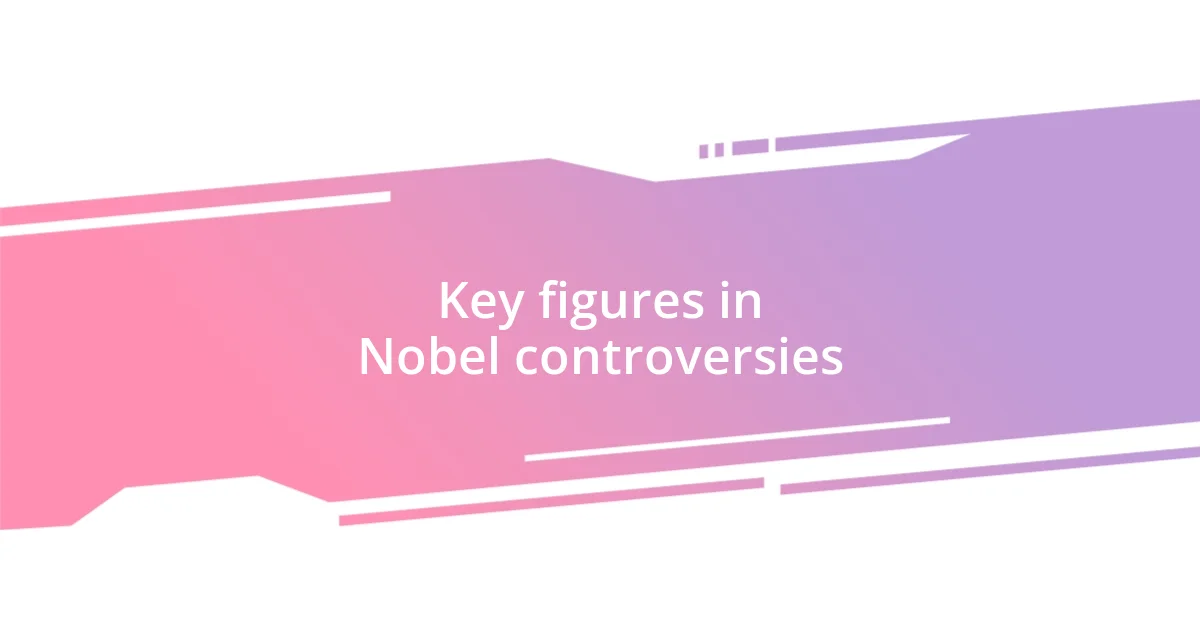Key takeaways:
- Understanding Nobel controversies requires recognizing the complex interplay between recipients’ personal beliefs, societal values, and cultural perceptions, fostering polarizing reactions.
- Approaching sensitive discussions involves using open engagement techniques, active listening, and creating safe spaces for dialogue to enhance understanding and empathy.
- Key lessons include practicing patience, empathy, and reflection, which can transform contentious debates into enlightening exchanges and promote personal growth.

Understanding Nobel controversy context
Understanding the context of Nobel controversies requires diving into the history and motivations behind the awards. For instance, many recipients, including literature laureates, have stirred debates due to their political beliefs or the themes of their work. It makes me wonder how often the essence of an author gets twisted in the public eye, especially when their message challenges the status quo.
Reflecting on my experiences, I’ve sensed that the controversies often stem from societal tensions. Take the case of certain peace prize winners whose selections prompted backlashes; it felt like I was witnessing a microcosm of larger global conflicts. Can one truly separate an artist or scientist’s work from their personal convictions? It’s a question that looms large in discussions surrounding these prestigious awards.
From my perspective, the intricacies of Nobel controversies don’t just lie in who receives the prize but also in how these choices resonate across varying cultural and political landscapes. Each award can symbolize hope for some and anger for others. It’s a vivid reminder that recognition, while celebrated, can also ignite fierce debates. Have you ever noticed how a single accolade can prompt polarized reactions? It certainly has for me, revealing how interconnected our world is through art, science, and humanity’s ongoing struggles.

Key figures in Nobel controversies
Key figures involved in Nobel controversies reveal the complex web of influence and sentiment surrounding these awards. Names like Bob Dylan, who became the first musician to receive the Nobel Prize in Literature, sparked intense discussions about what qualifies as “literature.” I recall debating with friends how his lyrics could be viewed as poetry, yet some felt the prize should remain firmly rooted in traditional prose. These conversations highlighted how subjective interpretations of art can lead to passionate disagreements, reinforcing the idea that recognition can be polarizing.
Here are some notable personalities often mentioned in Nobel debates:
- Yasser Arafat: His 1994 Peace Prize win raised eyebrows, as many viewed it as conflicting with his controversial leadership.
- Kawabata Yasunari: The Japanese author’s recognition was marred by discussions of cultural representation and wartime actions.
- Bob Dylan: His unconventional choice sparked questions about the definition of literature and artistic merit.
- Malala Yousafzai: The young activist’s award often leads to discussions on youth and activism in a political landscape.
Each of these figures serves as a lens to examine broader societal values and the criteria we use to honor contributions to humanity. It’s fascinating to me how these figures, despite their accolades, often become symbols in the ongoing debate about the purpose and impact of the Nobel Prize itself.

Approaching sensitive discussions
When I think about approaching sensitive discussions, especially those tied to Nobel controversies, it’s essential to navigate the conversation with care. I’ve often found that the tone we set can make all the difference. For instance, I recall a debate among colleagues where I intentionally used open-ended questions to foster a more inclusive environment. This technique not only eased tensions but also fostered deeper insights as participants felt they could express differing opinions without fear of backlash.
Creating a safe space for dialogue is crucial. I learned this during a panel discussion where emotions ran high due to differing viewpoints on a controversial laureate. By affirming the validity of everyone’s feelings, I noticed a remarkable shift; anger transformed into curiosity. This experience reinforced the idea for me that acknowledging the emotional weight behind these conversations helps bridge divides and promotes mutual understanding.
Here’s a comparison of two approaches I’ve seen in discussions about sensitive topics:
| Approach | Description |
|---|---|
| Open Engagement | Encourages sharing multiple perspectives, fostering a sense of community. |
| Defensive Dialogue | Leads to confrontation and polarization, often shutting down constructive conversation. |
Taking a thoughtful approach doesn’t just involve the words we choose but also how we listen and respond. I believe that genuine engagement can transform potentially contentious discussions into valuable exchanges of ideas, allowing for understanding where once there was division.

Techniques for engaging in debates
Engaging in debates, particularly on sensitive topics, requires a blend of confidence and humility. From my experience, one effective technique is to share personal stories that illustrate your point. I once recounted a moment from my college days when a heated discussion about a controversial Nobel winner turned into a heartfelt exchange, simply because I shared how their work had impacted my life. It’s amazing how vulnerability can draw people in and create empathy, allowing for a more profound dialogue.
Another strategy that’s proved invaluable is reframing disagreements as opportunities for learning rather than battles to be won. I’ve often posed the question, “What can we learn from differing views?” during discussions. This not only shifts the focus from proving someone wrong to understanding their perspective but also encourages participants to explore the nuances behind each opinion. I found that your approach towards conflict can either spark curiosity or reinforce division, and I always aim for curiosity.
Listening actively is perhaps the most underrated yet impactful technique I’ve employed. During a particularly passionate debate, I made a point to repeat back what my counterpart had said before responding. This simple act of acknowledgment not only made them feel heard but also opened the door for more constructive dialogue. Good debates aren’t just about arguing your point; they’re about growing together through shared understanding. How many times have we walked away from a discussion feeling more connected, simply because we listened intently?

Managing emotional responses
Managing emotional responses during sensitive discussions can be quite challenging. I’ve felt that urge to react defensively when confronted with differing opinions, especially on subjects like Nobel controversies. One memorable moment was when I found myself entangled in a debate where an assertive comment from a colleague triggered an emotional response in me. Instead of responding immediately, I took a moment to breathe and refocus. That pause helped me regain my composure and allowed for a more thoughtful response. Have you ever noticed how a brief moment of reflection can change the course of a conversation?
Another key aspect I’ve learned is recognizing the emotional undercurrents in discussions. I remember a time when a passionate participant expressed frustration over a laureate’s controversial decision. Rather than dismiss their feelings, I chose to empathize by stating, “I can see how that would be upsetting.” By validating their emotions, the atmosphere shifted; what could have escalated into conflict transformed into a genuine dialogue. I firmly believe that acknowledging emotions can diffuse tension and encourage openness.
It’s essential to be aware of my own triggers as well. I’ve found that creating a mental checklist before engaging in these discussions can be tremendously beneficial. Noting what might upset me allows me to prepare emotionally and ensures I approach the conversation with an open mind. How can we better prepare ourselves to engage without getting swept away by our emotions? For me, it’s about self-awareness and a commitment to understanding—not just being understood.

Encouraging open dialogue
Open dialogue thrives on the willingness to listen and share, creating a space where diverse ideas can flourish. I recall a roundtable discussion where we tackled the controversial aspects of a Nobel prize-winning work. Instead of jumping into counterarguments, we each took turns reflecting on why we valued certain contributions. This practice not only fostered mutual respect but also allowed us to unearth common ground that transcended our initial disagreements. Have you ever paused to truly absorb another person’s perspective? It’s a game-changer.
Another time, I facilitated a debate where I encouraged everyone to share not just their opinions, but also their motivations behind those beliefs. One participant revealed that their stance was heavily influenced by personal experiences with the social implications of the laureate’s work. This openness transformed the atmosphere. Suddenly, it wasn’t about who was right or wrong; it was about understanding the human stories behind our arguments. I believe that humanizing discussions can lead to more compassionate exchanges.
Lastly, I find humor can sometimes break the ice during serious conversations. There was a moment when a colleague inadvertently mixed up names of Nobel laureates during a heated discussion. Instead of letting the tension rise, we all laughed it off. That moment of levity reminded us we were all learning together, not just defending positions. How do we make our discussions less about winning and more about exploring? I’ve learned that a little laughter might just be the key to opening pathways for deeper dialogues.

Lessons learned from the experience
One critical lesson I’ve absorbed from navigating these controversial discussions is the importance of patience. I can vividly recall a time when I was pushed to my limits during a heated debate about a Nobel prize winner’s ethics. Instead of replying impulsively, I paused for a moment. That simple act of patience transformed my initial frustration into clarity, enabling me to articulate my thoughts more effectively. It makes you wonder—how many misunderstandings could be avoided if we just allowed ourselves a moment to breathe?
Empathy has also emerged as a guiding principle through these experiences. I remember a colleague who was highly passionate about their viewpoint, and their intensity almost made me want to shut down. However, choosing to listen actively and understand the emotions behind their stance helped me see beyond the argument. That choice opened a door to a connection I hadn’t anticipated. Isn’t it fascinating how making an effort to genuinely connect can reframe a contentious discussion into an enlightening exchange?
Lastly, I’ve come to appreciate the power of reflection after each discussion. After a particularly heated session, I took time to journal my thoughts, analyzing what went well and what could have been better. In reviewing those moments, I uncovered patterns in my reactions and discovered areas for growth. Have you ever considered how reflection can be a tool for transformation in our conversational skills? For me, it has become a cornerstone of learning and evolving.














